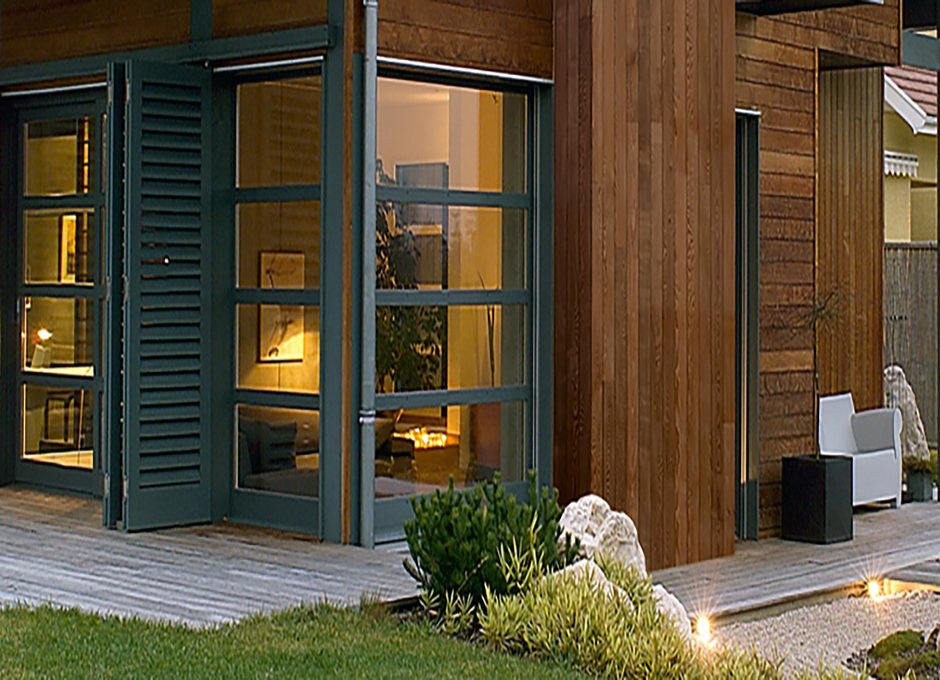
Are your shutters, partitions, cladding, gates, fences, garden sheds, windows, pergolas looking gloomy… Do you have a free weekend and the good weather is with you? Now is the ideal time to intervene! Take the opportunity to impregnate your vertical wooden cladding. Thanks to the use of high-quality resins, impregnation varnishes offer excellent resistance while providing an elegant and refined decoration. There are different types of wood impregnation varnishes depending on exposure to UV radiation and weather conditions. So follow our advice to choose the right impregnation varnish for your wood.
Before painting your exterior woodwork, make sure that the impregnation varnish will be applied to the desired surface. Impregnation varnish is only applied to vertical surfaces such as gates, doors, shutters, beams, windows, etc. Do not apply impregnation varnish to a horizontal surface (e.g. wooden table, verandas, etc.). Impregnation varnish is applied to vertical surfaces and is therefore not very resistant to scratches and abrasions due to repeated use. We advise you to apply floor varnish to interior wooden floors and floor impregnation – Saturateur/Decking Oil to your exterior veranda.
It is the combination of 3 basic criteria: lasting protection, ease of use and respect for people and the environment.
Lasting 4 to 8 years, impregnation varnishes provide long-term protection, on many types of wood, against bad weather conditions and UV rays in all climates and prevent them from discoloring. Microporous and water-repellent, impregnation varnishes allow wooden surfaces to breathe by regulating humidity.
Thanks to resins specially developed in the Blanchon – Syntilor factories, their impregnation varnishes combine quality and innovation. Odorless and 100% water-based, their rich gel-like texture makes them the perfect finish for large surfaces. Syntilor impregnation varnishes, which have an excellent filling effect, excellent coverage and a long-lasting finish, are very easy to apply. They can be applied both outdoors and indoors and offer easy maintenance.
Protecting the wood and preserving its natural appearance is one of the goals of impregnation varnishes. At the same time, however, they offer decoration, coloring and beautification, wherever they are applied. They leave the fibers and veins of the wood visible while providing a beautiful satin or matte velvety appearance.
As for the shades, they are available in a wide variety of tones and finishes. From classic to modern shades, highlight and reveal the natural beauty, authenticity and elegance of your wooden cladding, thanks to the extremely modern color schemes. A harmonious palette that gives all your wood a taste of beauty for long-term use.
Sand lightly between coats (grit 120 sandpaper) to remove minor roughness in the wood and achieve a beautiful appearance.
Slightly round off (grit 80 sandpaper) sharp corners and edges of exterior woodwork to facilitate the application of the impregnation varnish and ensure better protection.
On soft woods (very porous) subject to high exposure, a final coat of colorless impregnation varnish will ensure a noticeable and more durable finish. In renovation, colorless also helps to protect the wood without darkening it.
Recommendation: for exteriors, colorless finishes should be used in combination with one or two coats of colored impregnation varnishes.
If the wood does not look healthy (larvae traces or holes from wood-eating insects), you must treat them beforehand with a suitable wood treatment product such as Timpest Aqua Antitarlo (or a non-greasy treatment product), which will deeply impregnate and protect the wood. Let it dry for 48 hours before applying the impregnation varnish.
The impregnation varnish does not peel off, but over time the protective film degrades. Sand lightly and dust off. Then apply two new coats.
Precautions must be taken before applying to teak, iroko (exotic wood) etc.. Teak wood (and exotic wood in general) exhibits an accumulation of oily wood tannins that significantly reduce the adhesion of finishes. It is recommended to degrease the surface of the wood with acetone before applying the impregnation varnish of your choice.
The durability on lightly impregnated hardwoods such as Oak, Red Cedar, Iroko etc. is limited and reduced, as well as in the case of surfaces facing South or West.
2024 Ιnterkas All Rights Reserved | Terms & Conditions